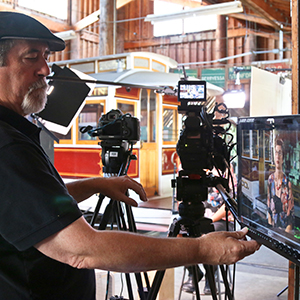

After all these centuries, a full-fledged documentary about San Jose‘s rich and lurid history will unfold next week at the California Theatre.
Produced by Norman Kline and CreaTV, in collaboration with History San Jose, and directed by Tricia Creason-Valencia, Changing Boundaries: The History of San Jose will explore the struggles of working people, visionaries, dreamers, farmers, political legends, sports figures and all sorts of unsung heroes who made San Jose what it is today. And since San Jose itself is essentially an unsung city, by its extension its people are the unsung ones. Don’t ever forget that.
So if you think there is no “here” here, if you can’t imagine anything historically interesting, or if you’re embarrassed to hail from San Jose—(“We’re just the burbs, ew!”)—your voice will be corrected and silenced and slaughtered after watching this film. Big time. In the words of a bearded wardrobe consultant: I guarantee it.
Several local luminaries appear in the film to yak about their direct experience with the various identities of San Jose. I phrase it that way because there will never be just one San Jose identity. This is a beautifully schizophrenic city and we’re proud of it. Not that I speak for everyone, of course. Some of the legends in the film include Blanca Alvarado, who can speak to decades’ worth of social justice issues related to the Chicano and Latino experiences. Former Mayor Tom McEnery chimes in with all sorts of history, as he’s known to do. Another former mayor, Norm Mineta, also provides harrowing details about his own experience with the Japanese internment camps. Local historians like Judge Paul Bernal and April Halberstadt provide necessary context in a variety of ways. Folks like SPUR director Leah Toeniskoetter and CEO of Silicon Valley Creates Connie Martinez provide contemporary insight about where the city might be headed in the future.
Obviously, a few centuries’ worth of historical threads cannot be embroidered into a single 80-minute film. No one involved claims that Changing Boundaries is the final word. The way I see it, the screening at the California Theatre is only the beginning. I can envision the film as a project that inspires people of all shapes and sizes to explore and document their own place in the history of this city. If you picked apricots 50 years ago or broke into empty swimming pools 30 years ago in order to skate, well, your story just might be an important part of San Jose history. For reals.
Director Tricia Creason-Valencia wants the film shown all over the place, everywhere, just for that reason: “For me, the point would be to show it in the community, in all different contexts. That’s what I do this for. I want to show it at MACLA, I want to show it at the Mexican Heritage Plaza, or the labor council. I want to show it to people who are going to think about and reflect on their part in this history. I’d love to be part of a panel discussion about those groups and say, ‘What is your angle on history and how can we learn more?'”
Creason-Valencia isn’t even a native. She’s only been here 10 years, but making the film taught her more than she ever expected. She says Changing Boundaries will shatter the mindsets of people who just automatically assume this landscape is nothing but suburban wasteland America filled with hideous subdivisions and the occaisonal meth-head blowing up his house.
“On one level, I just hope people say, ‘Wow. I had no idea,'” Creason-Valenica told me. “I think a lot of people rip on San Jose. They say, ‘Oh, it’s not San Francisco, it’s not the big city, it’s the burbs, it’s this, it’s that.’ But part of my argument is there’s actually a really rich history here. And you should take that into account. Because it’s really deepened my relationship to this place, having done this film, and I think that could be true for everybody.”
Changing Boundaries: The History of San Jose
Jan. 22, 6pm
$25-$50



